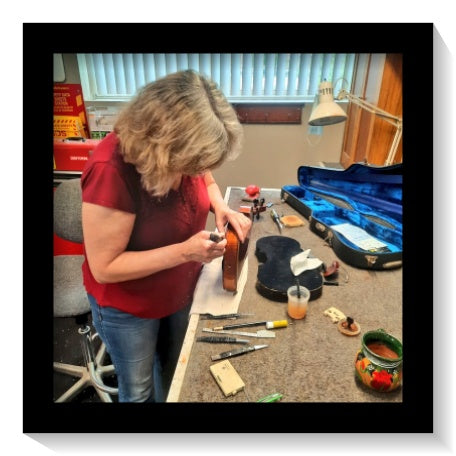
- Article published at:
- Article author: cassandra thuneman
- Article comments count: 0
Drawer menu
Welcome Back Last month we introduced the beginning of a series of small articles discussing the basic factors that go into pricing of instruments. As we stated last month, there are five basic priorities and requirements that are important to the buyer and five different ones for the seller. This month we will discuss the first and most important factor that goes into pricing from the sellers view.
Quality of Construction and Workmanship
This category is divided into two sections, with both halves being equally important. First half - Construction The first thing I do when a customer brings a violin in for evaluation is to look at its construction. Typically, one hallmark of a better instrument is it's wood quality.


These are all clues to its value. Let’s first look at the wood.
The first thing I look at is the back. This will show the personality of the instrument. The wood used on the back and sides is generally maple. Maple is typically a fairly hard wood which adds brilliance to the sound. There are other woods; like poplar, and willow that are used as well. These tend to give a softer sound and are most often seen on the backs of basses, cellos and some violas. The quality of the maple can either be highly figured or plain. The more highly figured maple backs and sides will command higher prices than relatively plain woods. Makers and workshops usually reserve the beautiful pieces of wood for their better, more carefully crafted instruments. What’s more, certain woods are now very scarce, like quilted maple. So an instrument built using this particular wood will certainly command a premium price.
Most violins use flamed maple; but quilted and Birdseye maple, found less often, are both spectacular. Flamed (or “curly”) maple exhibits tiger stripes. Figure #1. Quilted patterns look like a patchwork or like intersecting sets of waves. Figure #2. Birdseye figuring has many little eyes in the wood. Figure #3. By the way, the figuring has nothing to do with the tone of the instrument.
 Figure 1
Figure 1  Figure 2
Figure 2  Figure 3
Figure 3
Next, I examine the sides and neck. Unmatched wood suggests either an inexperience maker, or a massproduced instrument. Master-made instruments always have wood that matches.
Top Wood
 The last thing I look at is the top. Most tops are made of spruce. This wood is strong for its weight and vibrates easily, making it ideal for the way the top of a violin functions. We may even use different varieties of spruce for the different styles and levels of playing. Typically a straight,uniform spacing of the grain or reed lines seem to consistently sound good and respond well. This is what we see in our better instruments. However, there are exceptions.
The last thing I look at is the top. Most tops are made of spruce. This wood is strong for its weight and vibrates easily, making it ideal for the way the top of a violin functions. We may even use different varieties of spruce for the different styles and levels of playing. Typically a straight,uniform spacing of the grain or reed lines seem to consistently sound good and respond well. This is what we see in our better instruments. However, there are exceptions.
2. Varnish:

Another finished used sometimes is lacquer. Lacquer is a very hard finish and makes the sound choked and tinny. Despite this, it is used on a lot of factory-made instruments. Why? Because it's very reliable in the manufacturing process. It is cheap, readily available, (your local hardware store probably carries a can) easy to apply, and very easy to polish to a nice shine. Kids love shiny instruments and the parents who usually buy these violins don't understand what it does to the sound nor will they pay more for a sophisticated finish. The color of the varnish is totally unimportant to the sound, although it can carry some value, due to the
client’s taste.
3. Fittings:
Fittings can come in a variety of different woods. There is ebony, which makes the very best fittings, as well as boxwood, rosewood and stained hardwood. Ebony is an extremely hard wood and tends not to warp. Boxwood and its imitators tend to be softer and wear faster, but they do work very smoothly. Stained hardwood fittings are evidence of a lower quality violin. These fittings often warp and wear very poorly. Fittings can come in a variety of detailing as well. Some will have fancy carvings or inlays. This detailing doesn't add function, but can add a greater aesthetic appeal. There are different shapes and patterns to pegs and we have found about the easiest pegs to use is the

Swiss Professional pattern. They are easy to grip and turn which make them an ideal peg!
Next Month we will discuss the next part of this category which is:
Second Half- Workmanship